“In his day he did something for Ireland.”
– from My Ambition, A Young Man’s Song by T D Sullivan
On the morning of Friday 3rd April 1914, the remains of the great Irish patriot, Timothy Daniel Sullivan, were interred in Glasnevin Cemetery.1
Among the many expressions of sympathy, one described ‘T D’ as ‘a high type of a noble man with a wonderful faculty of putting touches of humour into his great poems or speeches … who never considered his personal advantages during his whole life, and whatever genius he possessed was entirely devoted to the uplifting of his country’.2
In the days of the Land League, Sullivan had addressed the crowd from the famous balcony of the Crown Hotel in Castleisland when all present had joined in with him in singing his composition, God Save Ireland.
High upon the gallows tree
Swung the noble-hearted three,
By the vengeful tyrant stricken in their bloom,
But they met him face to face
With the spirit of their race,
And they went with souls undaunted to their doom.3
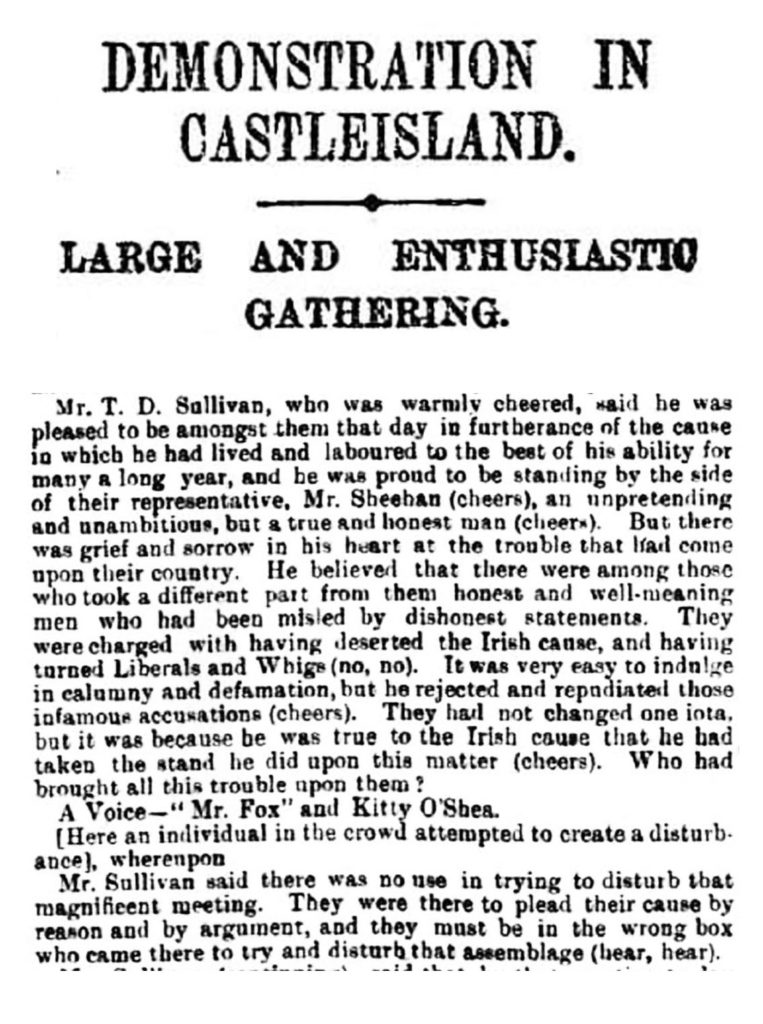
Maurice Murphy of the Crown Hotel received a letter from the son-in-law of the deceased, Timothy Michael Healy, MP, who writing from the House of Commons, stated, ‘I am crossing to Dublin tonight to bury poor T D Sullivan, we shall not look upon his like again’.
D B Sullivan, defender of Poff and Barrett
Timothy Daniel Sullivan was not the only member of the Sullivan family with links to Castleisland. His brother, Denis Baylor Sullivan, defended Poff and Barrett in their nineteenth century trials for the murder of Thomas Browne.
Sullivan was instructed by Tralee solicitor, Maurice J Horgan, who had concerns for Poff and Barrett at the preliminary investigations.4 Horgan had, at his own expense, made out briefs for counsel and requested that Denis Baylor Sullivan be instructed in the case.5
It might be argued that Denis Baylor Sullivan, who wrote the introduction to Speeches from the Dock, had no more chance of success in the defence of Poff and Barrett than would have John Philpot Curran, such was the state of criminal investigation at the time.6
Denis Baylor Sullivan, who had family links to Castleisland through his brother-in-law, John Cullinane (whose brother-in-law, William Martin Murphy, MP, married the daughter of James Fitzgerald Lombard Esq of Castleisland) died on Sunday 18 April 1909 at his Wicklow residence, ‘Dunboy’.7
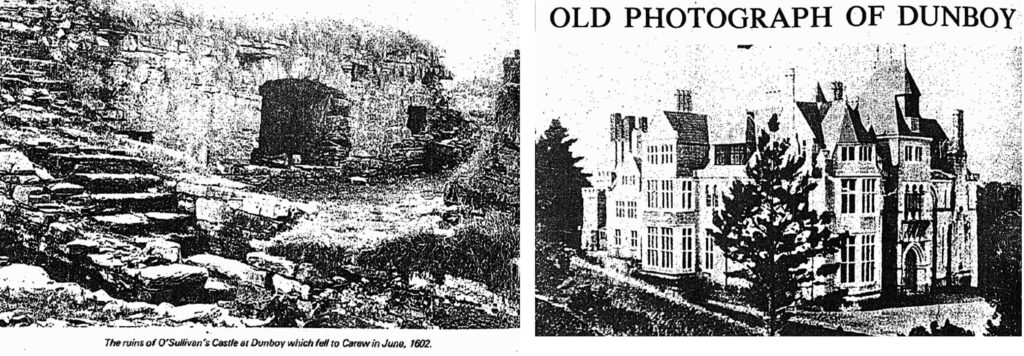
A Sketch of the Sullivan Family of Bantry
Daniel Sullivan Esq of Bantry, Co Cork, lineal descendant of O’Sullivan Beare, died at 71 Amiens-street, Dublin, in which city he had lived for about 25 years, on 26 March 1887. He was in the 86th year of his age.
Daniel was a devout Catholic and ardent patriot who taught his children from their earliest years to love and strive to serve their native land. He was described as a self- taught scholar and musician and in later years, a quiet, amiable gentleman who had no desire to take part in the struggles and contentions of political life. Yet he regarded with pride the positions his sons had achieved in literature, at the Bar, and in the political arena.
His wife was Catherine Baylor and the couple married in Bantry on 15 January 1826.8 Catherine, a national school teacher in Bantry, was described as a charitable lady who, though not rich herself, ‘always found something to share with the poor and afflicted’.
Mrs Catherine Sullivan died at Amiens Street, Dublin, on 19 April 1876. In Bantry, her native town, and elsewhere, shops and stores suspended business as a public demonstration of the respect in which the family was held.
It was said of Mrs Sullivan that she had given to national journalism five sons, who at one time were all together engaged upon the Nation newspaper and to her earnest and brave spirit was due ‘the bent of mind and the activity of intellect’ in her children:9
If but one of her sons had devoted himself to the cause of his country, the mother of Mr A M Sullivan would have a strong claim upon the affectionate regard of Ireland; but we know that the same spirit has animated all her children, though the paths through which they have sought to carry out her teachings were different.10
Children of Daniel and Catherine Sullivan
Timothy Daniel Sullivan (1827-1914)
Eldest and longest surviving son, MP, Lord Mayor of Dublin, author, journalist, described as the Rouget de Lisle of Ireland, was born in Blackrock Road, Bantry, Co Cork on 29 May 1827.
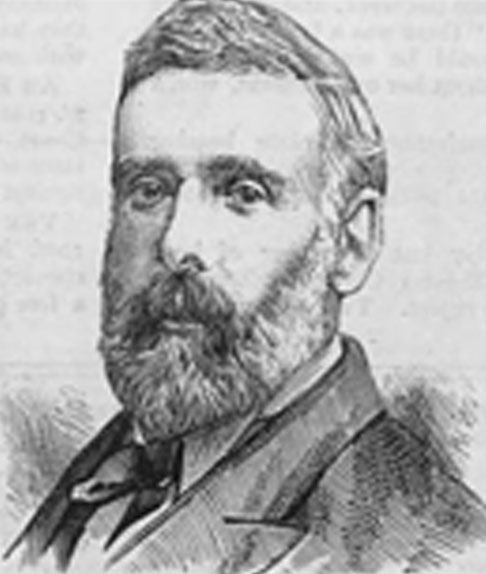
Timothy married his schoolteacher’s daughter, Catherine, daughter of Thomas Healy, in Bantry, on 6 July 1856 and they had a large family including Daniel Xavier Sullivan, who died aged 23 on 10 April 1882 at Newcastle, Sydney, New South Wales, to where he had travelled for the benefit of his health, and Dr Thomas D Sullivan, who died at Glenties Fever Hospital in June 1898. His eldest daughter, Catherine Mary Erina, who died in 1927, married Timothy Michael Healy MP (12 children recorded at bmdnotices.com) and another daughter, Anne Josephine, who died in 1953, married Dr Thomas Francis Higgins of Abbeyleix; their children included Thomas Francis O’Higgins (1890-1953) TD and politician Kevin Christopher O’Higgins (1892-1927) who was assassinated on 10 July 1927 (he left a widow, Brigid (nee Cole and later Mrs Arthur Cox) and two young daughters, Maev and Una). Mrs Catherine Sullivan died at 1 Belvedere Place Dublin on 3 November 1899 aged 61. Timothy Daniel Sullivan died at 1 Belvedere Place on 31 March 1914 in his 87th year. Among his many publications, Dunboy and Other Poems (1861).
Alexander Martin Sullivan (1829-1884)
MP for Louth and Meath, barrister, orator, journalist, man of letters.
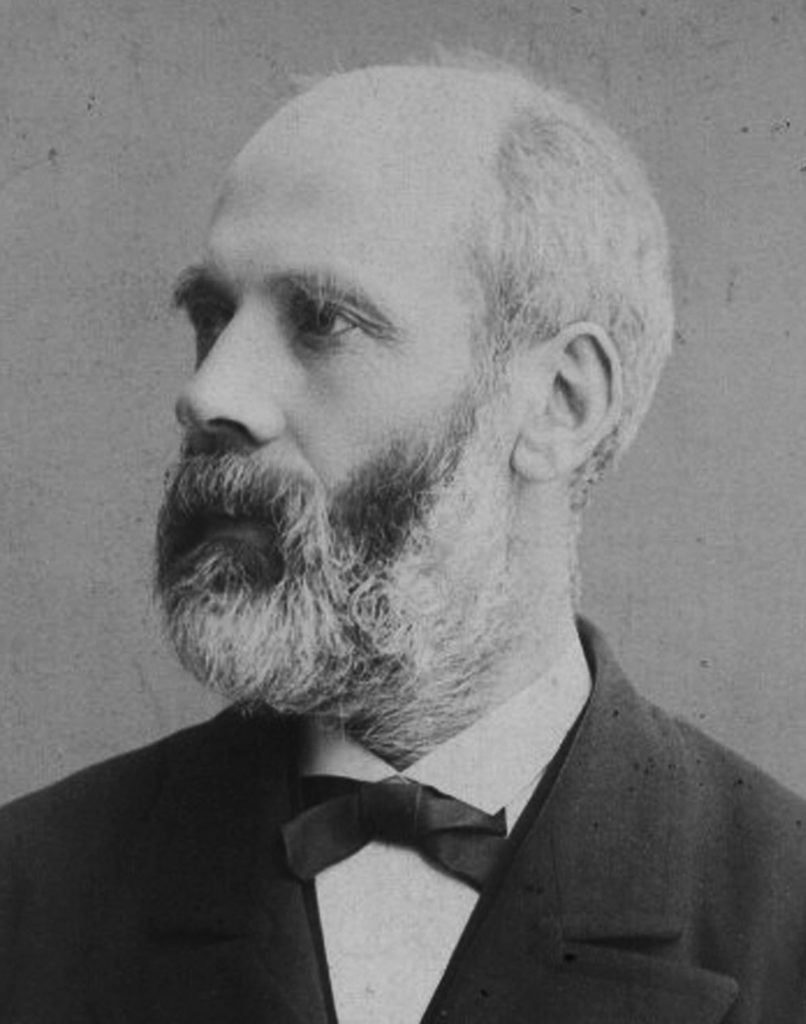
Educated at Berehaven National School. Edited the Nation. Prosecuted in 1868 for seditious writing and imprisoned for four months. Nominated Lord Mayor of Dublin but declined. Married Frances Genevieve, daughter of John Donovan of New Orleans in 1861. His daughter Mairéad Ghabhánach Sullivan, who died on 9 September 1967, was the wife of Charles Gavan Duffy. Another daughter, Anna Mary (died 1947) married her cousin, Maurice Healy, son of her father’s sister, Elizabeth. A sketch of Sullivan’s son and namesake, barrister and Serjeant-at-law, Alexander Martin Sullivan (1871-1959) is found in the Dictionary of Irish Biography. Alexander Martin Sullivan died 17 October 1884 and was buried in Glasnevin. His widow died on 29 January 1922. Their headstone records the deaths of their son, William Saunders Sullivan, who died from pneumonia at the Mater Misericordiae Hospital Dublin in the course of his work there, on 14 June 1912 aged 32; and three of their daughters, Frances Josephine Sullivan, Kathleen M Sullivan and Eileen Mary Sullivan. A M Sullivan A Memoir written by his brother, Timothy, was published in 1885. It was first serialised in the Nation in 1884. His principal literary works include A Visit to the Valley of Wyoming (1865), The Story of Ireland, which he dedicated to ‘my young fellow-countrymen / at home and in exile / in the cottage and the mansion / amidst the green fields and in the crowded cities / soon to be The Men of Ireland’ (about which William Carleton wrote to the author in 1868, ‘I felt as if I had been reading Irish history for the first time’ and Lady Wilde ‘Speranza’, declared the book had ‘no rival in our literature as a history’); and New Ireland (1877).
Among the chief mourners at A M Sullivan’s funeral the name Dr Kenny appears. Dr Joseph Edward Kenny (1845-1900), MP, son of Martin Kenny of Dublin, was by marriage related to cartoonist and artist, John Fergus O’Hea (1838-1922) who illustrated a number of Sullivan’s publications including Hofer and the Tyrol (1869) and The Story of Ireland (1870). Dr Kenny married Elizabeth Agnes, daughter of shoe merchant, John William Delany (1816-1890) of Dublin and Brussels, and niece of George Delany, at the British Embassy in Paris (and afterwards at the Church of the Madeleine by the Rev Father Dionysius, Superior of the Passionista, Paris) on 25 August 1873. They appear to have lived apart; little mention is made of the marriage. Elizabeth Agnes Kenny died on 22 April 1924 at St Hillier’s Nursing Home, Whitstable, Kent. Beneficiaries Joseph John Kenny and Nora, wife of Frederick Wesley Barnett. Elizabeth’s sister, Mary Theresa Delany, married Cork born cartoonist and artist, John Fergus O’Hea, ‘Spex’, son of barrister James O’Hea (1809-1882) on 18 November 1875 at the Pro-Cathedral, Marlborough-street, Dublin. They had a large family.
Elizabeth Anne Sullivan (c1833-1859)
Wife of Maurice Healy Esq (1828-1906), Clerk of the Bantry Union 1845-52, subsequently Lismore Union, to whom she was married on 21 May 1853 in Bantry. Maurice, son of Thomas Healy, was of the same family into which Elizabeth’s brother, T D Sullivan, also later married.
They had five children, including eldest son Thomas Joseph Healy (1854-1924), Timothy Michael Healy, MP (1855-1931) who married his cousin, Catherine Mary Erina Sullivan, daughter of T D Sullivan; and Maurice Healy (1858-1923), who married his cousin, Anna, daughter of A M Sullivan. Elizabeth Anne Healy died in Bantry on 14 January 1859 of puerperal fever in the 36th year of her age (this appears to be a misprint of 26, as her parents were not married until 1826). Maurice Healy died at the Private Hospital (Mater Misericordiae) in Dublin on 24 October 1906. He was buried in Lismore Cemetery. A note of condolence was addressed to his widow and sons T M Healy MP, Thos J Healy, Maurice Healy, solicitor and C J Healy.
Catherine Maria Sullivan (1836-1881)
Wife of Patrick Joseph Fogarty, Woodville Lodge, Cabra, Phibsborough, Dublin, to whom she was married at St Mary’s Cathedral, Marlborough Street, Dublin on 27 August 1866. In November 1876, P J Fogarty, who worked for the Nation in the ‘mechanical department’ was presented with an illuminated address at his residence, Woodville Lodge, Cabra, as a mark of appreciation of his many years work with the journal.
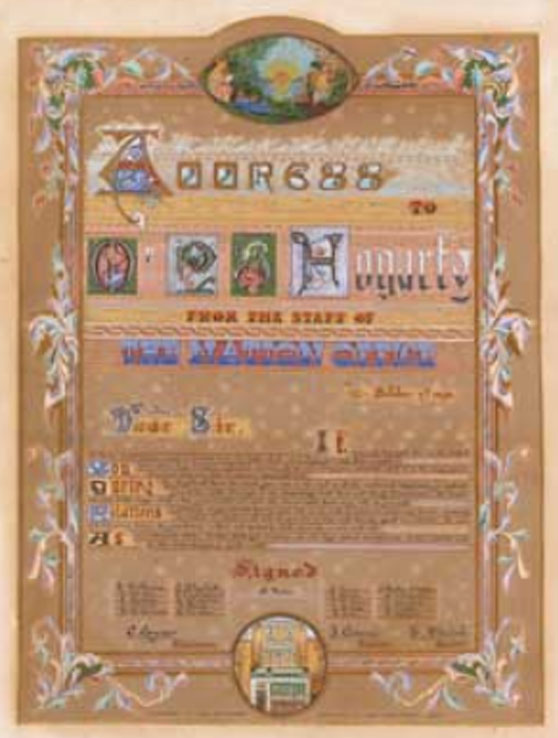
The address, the work of John Hutchinson, was mounted in a gilt frame, ‘a beautiful piece of artistic workmanship, the colouring being varied, chaste, and harmoniously toned … A mediaeval border in charmingly contrasted hues is in itself a work of art … at the head of the address there is an admirably executed illustrative view of Young Ireland and the lower portion of the vellum is most appropriately furnished with an excellent drawing of the Nation office’. Fogarty appears to have subsequently operated a printing works at Fleet Street, removing to Eustace Street in 1881. Catherine Maria Fogarty died on 17 June 1881 at Woodville Lodge, Cabra, in the 46th year of her age. Patrick Joseph Fogarty died on 27 February 1883 at his residence in Eustace Street, Dublin, aged 58. Their children suffered ill fortune: The death of Thomas, third son, at 21 Eustace Street, Dublin in the 23rd year of his age occurred on 31 January 1883; his brother, 17 year old Francis, fourth son, died at 33 Raymond Street, Dublin on 19 July 1885; 18-year-old Edward, youngest surviving son, died on 22 January 1891 at 27 O’Connell Avenue, Dublin.
Richard Sullivan or O’Sullivan (1837-1880)
Barrister, journalist, author.

Wrote for the Nation and the Dublin Morning News and contributed to the columns of the Weekly News tales of Irish life including The Privateers’ Revenge, Full Retribution and The Smuggler, published in one volume, Three Stories for the Fireside in 1867 (with subsequent editions). He lived afterwards in Australia and America, to where he had travelled for the good of his health. In Australia, he edited the Sydney Freeman’s Journal and in San Francisco, the Irish Catholic Monitor. He did not marry and died from pneumonia in St Mary’s Hospital, San Francisco on 17 January 1880. He was laid to rest in Calvary Cemetery.
Donal (or Daniel) Sullivan (1838-1907)
Politician and author.

Baptised in Bantry 13 July 1838 (at the same time as his brother Richard). MP for South Westmeath. Author of The Story of Room 15 (published in pamphlet form 1892, serialised in Nation 1891) which documented the Parnell divorce crisis of 1890. An extract is given here:
Room 15, which has now become historic, is one of the ordinary committee rooms situated a storey higher than the House itself and overlooking the river Thames. On this chilly evening neither lamps nor fire were lighted, and the room felt and looked dark and cheerless … the Irish members, to the number of sixty-one, streamed into Room 15. Their names were Abraham, Barry, Blane, Byrne, Corbett, Clancy, Crilly, Conway, Condon, Cox, Campbell, Dalton, Esmond, Foley, Finucane, Fitzgerald, Flynn, Fox, Jordan, E Harrington, Hayden, Harrison, Maurice Healy, Dr Kenny, M J Kenny, Kilbride, Knox, Lane, Leamy, Justin McCarthy, J Huntley M’Carthy, MacNeill, W A Macdonald, Peter M’Donald, M’Kenna, Morrogh, Mahony, Maguire, Murphy, Colonel Nolan, Joseph Nolan, John O’Connor, James O’Kelly, P J O’Brien, J F X O’Brien, R Power, Pinkerton, P J Power, Parnell, Quinn, Reynolds, Roche, Sexton, Sheehan, Stack, D Sullivan, Sheehy, Tanner, Tuite and Webb. Did any of them think then of the momentous consequences that were to follow the result of this meeting? Probably not even Mr Parnell himself dreamt of them. Messrs Molloy, Commins, Deasy, Arthur O’Connor and M’Cartan arrived either after the meeting was over or as it was about to break up. A slightly different list of names was published in the papers at the time but the above is believed to be an accurate one. Messrs Wm O’Brien, John Dillon, T D Sullivan, T P Gill and T Harrington were in America. Mr T M Healy was in Dublin, just convalescent after a serious illness, and no opportunity whatever was afforded to the party for consultation, deliberation, or communication in reference to the grave crisis that had arisen … Mr Parnell rose and all was suspense and expectation for the announcement of the fateful decision which was to have such far-reaching effects, and then a death-like silence fell on the Party, this stillness was made the more impressive by the gathering darkness and the gloomy aspect of the room. Every nerve was shrunk, and every ear strained to catch the words which each one felt would decide momentous issues … ‘I feel this re-election a proof of your continued confidence in me … I was able, with only one man by my side, to stand up and defy the House of Commons, and what have I now to fear with eighty-five colleagues at my back? … I will now lift aside a corner of the curtain … This is not the place to enter on a vindication of myself against the vile charges that have been made against me and I do not intend to do so, but I will ask my colleagues to remember that only one side of the story has been given to the public. I am accused of breaking up a happy home, and of shattering a scene of domestic bliss and felicity. If this case had been gone into, a calculation had been made, and it would have been proved that in the twenty-three years of Mr O’Shea’s married life he only spent 100 days in his own home. This was the happy home which I am alleged to have destroyed. I am also accused of betraying a friend. Mr O’Shea was never my friend. Since I first met him in Ennis, in 1880, he was always my enemy. You may examine the pages of Hansard, and you will not find that I ever on any occasion referred to him as my friend. There is the further charge against me that I abused this man’s hospitality, but I never partook at any time of Mr O’Shea’s hospitality for I never had bit or sup at his expense. I will not dwell any more on this subject except to say that of the two principal witnesses in the case, one was a drunkard and the other a thief. Now that I have lifted a corner of the curtain, I will only ask you, gentlemen, to keep your lips sealed, as mine are, on what you have heard until the brief period of time will have elapsed to which I have referred, when I can vindicate myself.’ … In a few minutes this formal business was over … Amazement, consternation and blank dismay fell on the Party …
Donal Sullivan never married. He died in London on 3 March 1907. His remains were returned to Glasnevin for burial in the family grave, close to the O’Connell circle. Obituary and image of Sullivan in Westmeath Independent, 9 March 1907.
Denis Baylor Sullivan (1845-1909)
Journalist, barrister, author.
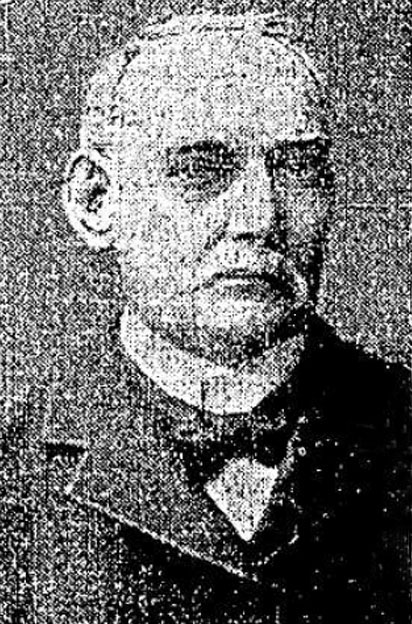
Educated at St Laurence O’Toole’s Schools, Harcourt Street and the Catholic University. Edited the Morning (later the Weekly) News, a newspaper started by his brother Alexander. Called to the Bar in 1875 and defended Timothy Kelly in the Phoenix Park Trials and also the Poff and Barrett trials. Appointed QC in 1889. He married in 1876 at Skibbereen, Harriet, youngest daughter of Jeremiah Cullinane of Skibbereen; their sons were Joseph (b1878), Richard (b1881) and Denis Brendan (b1884). A daughter, Mary, was born in 1888 (Harriet Mary Frances Sullivan of ‘Dunboy’, Greystones, Co Wicklow died on 22 November 1973).
It is worth noting that Harriet’s brother, John Cullinane (1838-1900) married, in 1872 in Bantry, Margaret Murphy (1843-1936) older sister of William Martin Murphy (1845-1919) MP. William Martin Murphy was married on 8 January 1870 to Mary Julia, only daughter of James Fitzgerald Lombard Esq JP of South Hill, Rathmines, Co Dublin and his wife Margaret Tuite (Margaret died 8 February 1871). Mary Julia Murphy died in Dublin on 11 December 1900. James Fitzgerald Lombard, who died on 23 December 1901, was a native of Castleisland.
Denis Baylor Sullivan of ‘Dunboy’, Greystones, Co Wicklow, died on Sunday 18 April 1909. Harriet died at the same address on Christmas Day 1940. Obituary and image of Sullivan in Sunday Independent, 25 April 1909.
__________________
1 The funeral, conducted by Archbishop Walsh and Reverends Dawson, E Byrne, Coffey and O’Dwyer, was strictly private. Wreaths were sent by the Lord Lieutenant and Lady Aberdeen, Mr and Mrs William O’Brien, Miss M Cullinane, Bantry; Mr and Mrs Fisher-Unwin, Mrs Kathleen Waters, Mrs Alicia Needham, Miss H Rose-Byrne, Mr Patrick McAnaspie, Dr and Mrs Higgins and the Misses Healy. 2 Irish Examiner, 11 April 1914. 3 The four verse song was published under title, ‘Song. Air – Tramp, tramp, tramp, the boys are marching’ in the Dublin Weekly Nation, 7 December 1867. ‘The publication of God Save Ireland created something like a sensation throughout the country and almost at once became the recognised National Anthem. Its popularity among Nationalists was only equalled by the ferocity with which it was banned by the authorities. In many parts of Ireland – more especially in the south and west – it was a criminal offence under the Coercion Act to sing it’ (Nenagh News, 4 April 1914). 4 Maurice James Horgan of 28 Denny Street, Tralee, was born near Ballyduff, Co Kerry, c1857 and studied at Queen’s College Cork. He was admitted a solicitor in 1881 and within seven or eight years had attained the position of being one of the leading solicitors in Tralee from the many memorable cases ‘on the national side’ with which he was identified. In this way he was able to take an active part in advancing his country’s cause. He was described as a man of striking physique with a genial and warm-hearted nature. He died on 4 January 1889 after a long illness at the early age of 32, leaving a widow, Margaret C Horgan, and young child. Only a few days prior to his death he had received instructions from the solicitors representing the Irish party to collect the necessary evidence in Kerry to rebut the Times allegations before the Royal Commission. It was remarked: ‘He always did his duty to his clients fearlessly and manfully, while at the same time he treated the bench with every respect and courtesy. In fact his conduct in court was characteristic of his whole nature, which was eminently that of a brave and generous person … his early death has cut short what promised to be a successful career’ (Kerry Sentinel, 5 & 9 January 1889). He was buried at the family burial place in Rattoo. 5 During the second trial, the cross examination of Sub-Inspector Davis, Castleisland, by George Lawrence (also acting for the defence) about a bottle of whisky found near the place where two men had been seen running away from the murder scene gave a water-tight alibi to two men by the name of Fitzgerald, who lived near the victim Browne, and with whom unfriendly feelings were known to exist. The defence observed that bottles of the description found in the field were not in the houses of publicans at Scartaglen, where Poff and Barrett had been drinking, but there was one publican in Castleisland who had them. Asked why he did not arrest the Fitzgeralds, who lived nearby, Sub-Inspector Davis replied that he knew where they were on the day of the murder, ‘They spent that day in a public-house opposite my lodgings in Castleisland’. An illustration of the humour sometimes evinced in court was revealed when D B Sullivan represented seven men in the Bruff Riot case. In December 1882, Sullivan applied for the prisoners to be allowed out pending their trial on 3 January 1883. One of the prisoners drew laughter when he stated they had no money to take them home to Bruff and if they had to walk it would take them three days, and they might be arrested under the Coercion Act. 6 Speeches from the Dock was published in 1904, produced by three of the Sullivan brothers, Timothy Daniel, Denis Baylor and Alexander Martin. It gathered together the words of great political figures in Irish history. 7 John Cullinane (1838-1900) married, in 1872 in Bantry, Margaret Murphy (1843-1936) older sister of William Martin Murphy (1845-1919) MP. William Martin Murphy was married on 8 January 1870 to Mary Julia, only daughter of James Fitzgerald Lombard Esq JP of South Hill Rathmines, Co Dublin and his wife Margaret Tuite (Margaret died 8 February 1871). Mary Julia Murphy died in Dublin on 11 December 1900. James Fitzgerald Lombard, who died on 23 December 1901, was a native of Castleisland. 8 Catherine was born in 1799. The marriage was witnessed by James or Timothy Sullivan and John Casey. 9 ‘In the troublesome times of 1867, ’68 and ’69, I walked three or four miles to get a copy of the Weekly News and Nation, and at that time there was not much literature for the people as now. Mr Sullivan and his brother always kept the national cause before the people when there was great opposition’ (Obituary, Irish Examiner, 11 April 1914). 10 Nation, 22 April 1876.


